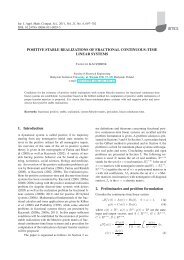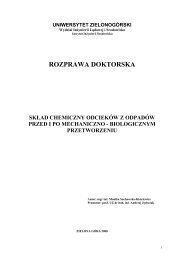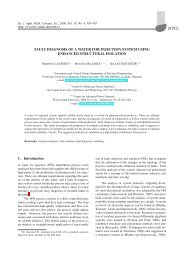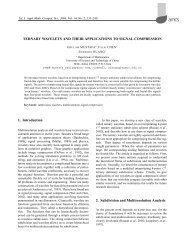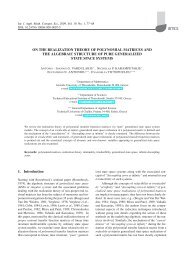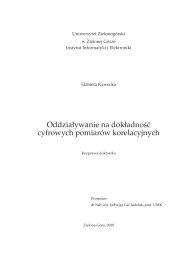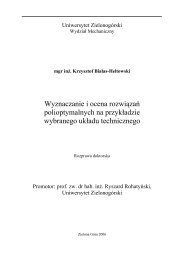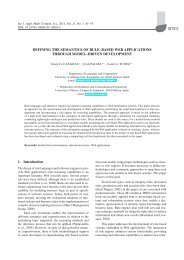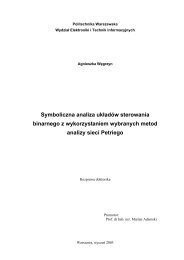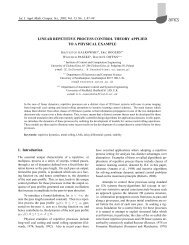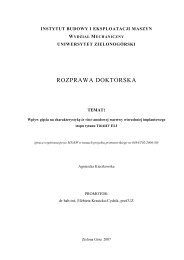MESH r-ADAPTATION FOR UNILATERAL CONTACT PROBLEMS ...
MESH r-ADAPTATION FOR UNILATERAL CONTACT PROBLEMS ...
MESH r-ADAPTATION FOR UNILATERAL CONTACT PROBLEMS ...
You also want an ePaper? Increase the reach of your titles
YUMPU automatically turns print PDFs into web optimized ePapers that Google loves.
Int. J. Appl. Math. Comput. Sci., 2002, Vol.12, No.1, 9–16<br />
<strong>MESH</strong> r-<strong>ADAPTATION</strong> <strong>FOR</strong> <strong>UNILATERAL</strong> <strong>CONTACT</strong> <strong>PROBLEMS</strong> †<br />
PIERRE BÉAL ∗ , JONAS KOKO ∗∗ , RACHID TOUZANI ∗∗∗<br />
∗ NUMTECH–27, rue Jean Claret, Parc Technologique de La Pardieu,<br />
63 063 Clermont-Ferrand Cedex 1, France,<br />
e-mail: beal@numtech.fr<br />
∗∗ Laboratoire d’Informatique, de Modélisation et d’Optimisation, des Systèmes – CNRS/FRE 2239,<br />
Université Blaise Pascal (Clermont-Ferrand II), 63 177 Aubière Cedex, France,<br />
e-mail: koko@isima.fr<br />
∗∗∗ Laboratoire de Mathématiques Appliquées – CNRS/UMR 6620,<br />
Université Blaise Pascal (Clermont-Ferrand II), 63 177 Aubière Cedex, France,<br />
e-mail: touzani@math.univ-bclermont.fr<br />
We present a mesh adaptation method by node movement for two-dimensional linear elasticity problems with unilateral<br />
contact. The adaptation is based on a hierarchical estimator on finite element edges and the node displacement techniques<br />
use an analogy of the mesh topology with a spring network. We show, through numerical examples, the efficiency of the<br />
present adaptation method.<br />
Keywords: unilateral contact, linear elasticity, mesh adaptivity, node movement<br />
1. Introduction<br />
In contact mechanics the determination of the contact region<br />
is often a challenging issue. It generally depends<br />
on the algorithm of contact detection and its accuracy<br />
strongly depends on the mesh size. For these reasons, it<br />
seems natural to consider very fine meshes in the neighbourhood<br />
of this unknown region by making use of mesh<br />
adaptation techniques.<br />
The aim of this paper is to present an algorithm<br />
of topology preserving mesh adaptation. It is based on<br />
a node movement rather than on mesh classical refinement/coarsening<br />
techniques. The choice of this so-called<br />
r-adaptation strategy is motivated at least by two reasons:<br />
node movement techniques preserve the matrix structure<br />
and are then well suited for large-scale computations, e.g.<br />
three-dimensional and/or nonlinear cases. Moreover, they<br />
are well adapted for differentiation with respect to node<br />
positions in order to calculate sensitivities like, for instance,<br />
in shape optimization.<br />
The r-adaptation techniques are not new but are not<br />
popular in the numerical analysis literature. The reason<br />
for this is their lack of flexibility and their ability to generate<br />
unaesthetic meshes with a risk of degeneracy. In<br />
the present work we show that a lot of accuracy can be<br />
† This work was supported by the MFP MICHELIN<br />
recovered by slightly concentrating the mesh in the regions<br />
where “something happens”, e.g. in the contact region<br />
and especially in the vicinity of its boundary, where<br />
the contact pressure fails to be smooth. It turns out that<br />
in the literature one can mainly distinguish two types of<br />
r-adaptation formulations.<br />
The first one consists in formulating the mesh adaptation<br />
problem as an energy minimization one, the optimization<br />
parameters being the solution of the boundary value<br />
problem as well as the position of mesh nodes. Clearly,<br />
this approach is possible only if the boundary value problem<br />
is equivalent to a minimization one, which is the case<br />
for frictionless contact elasticity problems. Such a method<br />
was studied in (Haslinger et al., 1992), where mathematical<br />
results of existence of an optimal mesh are proved. In<br />
(Tourigny and Hülsemann, 1998), the authors give an iterative<br />
procedure to obtain an optimal mesh. The method<br />
is essentially based on a Gauss-Seidel-like method. Our<br />
tests show that although the method is attractive as it is<br />
well adapted for the problem formulation, the iterative algorithm<br />
seems to diverge in some situations, and even in<br />
the cases where it converges, edge swapping of the triangles<br />
is required. This constraint obviously alters the mesh<br />
topology. Let us note that, in addition, all optimization<br />
approaches create a difficulty related to the fact that the<br />
nondegeneracy of the triangulation must be imposed as a<br />
constraint in the problem, and that this constraint must be
10<br />
satisfied at each iteration of the optimization process. This<br />
issue requires then the use of the interior penalty method,<br />
which significantly complicates the setting of the mesh<br />
adaptation problem.<br />
In the present work, we adopt an adaptation technique<br />
based on hierarchical estimators. In other words, we<br />
use higher-order interpolation to evaluate local errors. It is<br />
noteworthy that edge-based errors are well suited for contact<br />
problems due to their ability to generate anisotropic<br />
meshes. These were introduced mainly in (D’azevedo,<br />
1991; D’azevedo and Simpson, 1991; Habashi et al.,<br />
1996). We formulate these techniques in the case of a<br />
mesh r-adaptation procedure. It turns out that, with some<br />
restrictions that will be outlined in the paper, the adaptation<br />
allows using a moderately coarse mesh with an acceptable<br />
accuracy.<br />
The paper is organized as follows: in the next section,<br />
we present a model linear plane strain elasticity problem<br />
with Signorini’s contact condition. We define a standard<br />
finite-element approximation of the problem and an iterative<br />
procedure to solve the discretized contact problem.<br />
Section 3 is devoted to the presentation of the mesh adaptation<br />
procedure. In particular, an important issue is the<br />
recovery of the hessian of the approximate solution. The<br />
mesh movement algorithm is also described. Section 4<br />
presents some numerical tests to confirm the validity and<br />
efficiency of the method. Finally, in Section 5 some conclusions<br />
are drawn about the described method and some<br />
possible future developments.<br />
2. Problem Statement<br />
In this section, we recall the setting of a unilateral contact<br />
Signorini problem for linear elasticity. We consider a<br />
deformable body occupying in its reference configuration<br />
a domain Ω of R 2 with boundary Γ divided into three<br />
disjointed subsets Γ D , Γ N and Γ C . We consider furthermore<br />
a rigid obstacle described by the curve x 2 = φ(x 1 ).<br />
We assume that the domain, in its reference configuration,<br />
is located “above" the obstacle, i.e.<br />
x 2 ≥ φ(x 1 ) for all x = (x 1 , x 2 ) ∈ Ω.<br />
.<br />
.. .<br />
Γ N<br />
.<br />
x 2 = 0<br />
Γ D<br />
Ω<br />
.<br />
Γ C<br />
.<br />
Γ N<br />
. . . . . . . . . . . . . . . . . . . . . . . . . . . . . . .<br />
. . . . . . . . . . . . . . . . . . . . . . . . . . . . . . . .<br />
. . . . . . . . . . . . . . . . . . . . . . . . . . . . . . .<br />
Fig. 1. A unilateral contact problem (φ(x 1) = 0).<br />
P. Béal et al.<br />
Let d denote the contact distance function defined by<br />
d(u)(x) := φ(x 1 ) − x 2 − u 2 (x),<br />
where u(x) = (u 1 (x), u 2 (x)) is the displacement of the<br />
point x. The set of admissible displacements is defined by<br />
V := {v ∈ H 1 (Ω; R 2 ); v = 0 on Γ D , d(v) ≤ 0 on Γ C },<br />
where H 1 (Ω; R 2 ) is the space of vector valued functions<br />
v such that<br />
∫ (<br />
∣ |v| 2 +<br />
∂v ∣∣∣<br />
2<br />
∣ ∣ +<br />
∂v ∣∣∣ 2)<br />
∂x 1<br />
∣ dx < +∞.<br />
∂x 2<br />
Ω<br />
Here, we have placed the deformed domain above the obstacle.<br />
Moreover, we have imposed a Dirichlet boundary<br />
condition on Γ D and a traction free boundary condition<br />
on Γ N . We assume furthermore that the boundary Γ D<br />
does not interact with the obstacle in the deformed configuration.<br />
The energy functional is given by<br />
W: v ∈ V ↦→ W (v) = 1 ∫<br />
2 a(v, v) − f · v dx<br />
Ω<br />
∫<br />
− g · v ds ∈ R,<br />
Γ N<br />
where a is the bilinear symmetric form defined by the<br />
linear elasticity problem. Namely,<br />
a(u, v) =<br />
2∑<br />
i,j,k,l=1<br />
∫<br />
Ω<br />
c ijkl ε ij (u)ε ij (v) dx, (1)<br />
and f (resp. g) is a smooth function that stands for the<br />
applied body (resp. boundary) force. In (1), (c ijkl ) is the<br />
tensor of elastic coefficients and<br />
ε ij (u) = 1 ( ∂ui<br />
+ ∂u )<br />
j<br />
, 1 ≤ i, j ≤ 2<br />
2 ∂x j ∂x i<br />
is the symmetric tensor of infinitesimal deformations. We<br />
choose here the case of an isotropic and homogeneous material,<br />
i.e. (c ijkl ) is given by<br />
c ijkl =µ(δ ik δ jl +δ il δ jk )+λδ ij δ kl , 1≤i, j, k, l ≤2,<br />
the real numbers λ ≥ 0 and µ > 0 denoting the Lamé<br />
coefficients of the material, and δ ij being the Kronecker<br />
delta. These coefficients are related in plane deformations<br />
to the Young modulus E and Poisson coefficient ν by<br />
the relationships<br />
λ =<br />
νE<br />
(1 + ν)(1 − 2ν) , µ = E<br />
2(1 + ν) .<br />
The equilibrium problem consists in seeking a minimum<br />
of the functional W :<br />
Find u∈V such that W (u) ≤ W (v) for all v ∈V. (2)
Mesh r-adaptation for unilateral contact problems<br />
It is well known (Kikuchi and Oden, 1988) that the solution<br />
to Problem (2) satisfies the variational inequality<br />
⎧<br />
u ∈ V,<br />
∫<br />
⎪⎨<br />
a(u, v − u) ≥ f · (v − u) dx<br />
⎪⎩<br />
Ω<br />
2.1. Discrete Problem<br />
∫<br />
+ g · (v − u) ds for all v ∈ V.<br />
Γ N<br />
Let us consider now a finite element approximation of<br />
Problem (2). We assume that the domain Ω is polygonal<br />
and we consider a triangulation K h of Ω into triangles<br />
of diameters ≤ h. We define the space<br />
X h = { v ∈ C 0( Ω; R 2) ; v |K ∈ (P 1 ) 2<br />
for all K ∈ K h , v = 0 on Γ D<br />
}<br />
,<br />
where P 1 is the space of affine polynomials. Let<br />
(a i ) 1≤i≤I denote the set of nodes on Γ C . We define furthermore,<br />
for v ∈ X h , the contact distance at nodes a i<br />
of Γ C by d i (u) := d(u)(a i ), 1 ≤ i ≤ I. We also define<br />
the set<br />
V h := { v ∈ X h ; d i (v) ≤ 0, 1 ≤ i ≤ I } .<br />
Notice that here, the set V h is not included in V. This<br />
feature is at the origin of some numerical difficulties in<br />
contact problems.<br />
For each function v ∈ X h , we define a function<br />
d h (v) on Γ C , which is continuous, piecewise linear<br />
and which coincides with d i (v) at node a i , for all<br />
i ∈ {1, . . . , I}. The discrete problem is defined by<br />
Find u h ∈ V h such that<br />
2.2. Penalty Solution Method<br />
W (u h ) ≤ W (v) for all v ∈ V h .<br />
In order to solve the constrained optimization problem (3),<br />
we use a standard external penalty method. For this, we<br />
define for ε > 0 the penalized energy functional<br />
W ε (v) := W (v) + 1 ∫<br />
(d h (v) + ) 2 ds.<br />
2ε Γ C<br />
The penalized problem is defined by:<br />
Find u h ∈ X h such that<br />
W ε (u h ) ≤ W ε (v) for all v ∈ X h .<br />
(3)<br />
(4)<br />
It is well known and easy to prove that the unique solution<br />
to Problem (4) converges, in the energy norm, to the<br />
solution to Problem (3) as ε → 0.<br />
Here, the principal interest of the penalized problem<br />
(4) is that the nonpenetration constraint is removed. It<br />
can be also shown that the solution to Problem (4) solves<br />
the variational problem<br />
⎧<br />
u h ∈ X h ,<br />
⎪⎨<br />
a(u h , v) + 1 ∫<br />
d h (u h ) + v 2 ds<br />
ε<br />
(5)<br />
Γ C<br />
∫ ∫<br />
⎪⎩ = f · v dx+ g · v ds for all v ∈X h .<br />
Ω<br />
Γ N<br />
The obtained problem is thus a nonlinear one due to the<br />
nonlinearity of the boundary integral in the variational formulation<br />
(5). It remains then to build an iterative scheme<br />
to solve the nonlinearity.<br />
2.3. Iterative Procedure<br />
In order to solve the nonlinear problem (5), we consider<br />
the following simple iterative scheme:<br />
⎧<br />
Given (u h ) n ∈ X h ,<br />
Find (u<br />
⎪⎨<br />
h ) n+1 ∈ X h such that<br />
a ( (u h ) n+1 , v ) + 1 ∫<br />
α n d h( (u h ) n+1) v 2 ds<br />
ε Γ C<br />
∫<br />
∫<br />
⎪⎩ = f · v dx + g · v ds for all v ∈X h ,<br />
Ω<br />
Γ N<br />
for n = 0, 1, 2, . . . , where<br />
α n =<br />
{<br />
1 if d h ((u h ) n ) > 0,<br />
0 otherwise.<br />
Hence the iterative procedure consists, for each iteration<br />
step, in detecting contact for each node by using displacements<br />
at the previous iteration.<br />
Numerical experiments have shown good properties<br />
of this iteration process: in all cases convergence is<br />
achieved in some iterations.<br />
Remark 1. Although the penalty term involves integrals<br />
of polynomials of degree 2, we use the trapezoidal rule<br />
to evaluate it in order to avoid well-known numerical<br />
locking.<br />
11
12<br />
3. Mesh r-Adaptation<br />
Let us define our r-adaptation method. It uses, like most<br />
of mesh adaptation algorithms, an a posteriori error estimator.<br />
The estimator here is said to be hierarchical in the<br />
sense that it is based on a P 2 -approximation of the solution.<br />
The presented method was developed by Peraire<br />
et al., (1992), Habashi et al., (1996), D’azevedo and<br />
Simpson, (1991), and Fortin, (1998). It is often used for an<br />
h-adaptation method, i.e. adaptation by mesh refinement<br />
of coarsening. We use it here for an r-adaptation.<br />
Let us present the method as briefly as possible, since<br />
the details can be found in the papers (D’azevedo and<br />
Simpson, 1991; Fortin, 1998; Habashi et al., 1996; Peraire<br />
et al., 1992). Consider a triangle K and a polynomial ũ h<br />
of degree 2 on K. In practice, ũ h will stand for the restriction<br />
to K of a piecewise P 2 approximation of the<br />
solution to the problem. We consider furthermore the P 1 -<br />
interpolate of ũ h , denoted by u h . Let e h = ũ h − u h .<br />
It can be shown (D’azevedo and Simpson, 1991) that the<br />
error function e is proportional to the hessian H of ũ h .<br />
Using this property, we adopt the following adaptation criterion:<br />
We seek a mesh that achieves an equidistribution<br />
of the error e h on the edges of the triangulation. Therefore,<br />
if E is an edge of the triangulation and if τ E is the<br />
unit tangent to E, the second derivative along the τ E -<br />
direction is given by<br />
∂ 2 u<br />
∂τ 2 E<br />
= τ T EHτ E .<br />
Let x k and x l denote the two vertices of the edge<br />
E. If the (constant) matrix H is semi-positive definite,<br />
we define the error estimator on E by<br />
e kl = (a T klHa kl ) 1 2 .<br />
Note that, in the case where H is positive definite, this error<br />
defines a new metric on the edge E. In this case, error<br />
equidistribution on the edges is equivalent to prescribing<br />
that all the edges have the same length in the metric associated<br />
to H.<br />
3.1. Practical Computation of the Estimator<br />
The calculation of the error e kl can be achieved in the<br />
following way: if g is the gradient of ũ h and if we note<br />
that this one is an affine vector on the edge E, we have<br />
⎛<br />
Ha = ⎜<br />
⎝<br />
a T kl<br />
a T kl<br />
where g k = g(x k ).<br />
∂g<br />
⎞<br />
∂x 1<br />
⎟<br />
∂g<br />
⎠ = ∂g = g<br />
∂a k − g kl ,<br />
kl<br />
∂x 2<br />
P. Béal et al.<br />
When the matrix H is not semi-positive definite, we<br />
consider (as in (Fortin, 1998)) the spectral decomposition<br />
of H:<br />
H = R T Λ R,<br />
where Λ is the diagonal matrix of the eigenvalues of H.<br />
Let us denote by |Λ| the matrix obtained from Λ by replacing<br />
the eigenvalues with their absolute values and with<br />
|H| the matrix<br />
Using the inequality<br />
|H| = R T |Λ| R.<br />
|b T H b| ≤ b T |H| b for all b ∈ R 2 ,<br />
we replace the hessian matrix H with |H|. We now want<br />
to calculate the error<br />
e kl = ( a T kl|H|a kl<br />
) 1<br />
2<br />
using ũ h . If â ij = Ra ij and ĝ = Rg, we have<br />
a T kl|H|a kl = a T klR T |Λ|a kl<br />
= a T klR T (|ĝ k | − |ĝ l |)<br />
= a T klR T (|Rg k | − |Rg l |).<br />
It remains now to calculate the hessian. The difficulty<br />
lies in the fact that, since the approximate solution u h is<br />
only continuous, its second partial derivatives are Dirac<br />
distributions on element edges. To approximate these distributions,<br />
we proceed as follows: A continuous approximation<br />
of the hessian matrix entries is obtained by the<br />
following projection:<br />
H ij (x k ) ≈<br />
∫Ω k<br />
∂ 2 u h<br />
(6)<br />
φ k dx<br />
∂x i ∂x<br />
∫ j<br />
, (7)<br />
φ k dx<br />
Ω k<br />
where φ k is the basis function associated with node x k<br />
and Ω k is the union of triangles that share this node. Let<br />
us point out that the above integrals are actually duality<br />
brackets since, as has previously been mentioned, the<br />
second-order derivatives of the approximate solution are<br />
only distributions. Effective calculation of the above expression<br />
is then obtained with the use of Green’s formula:<br />
H ij (x k ) ≈<br />
∫Γ k<br />
∂u h<br />
φ k n j ds −<br />
∂x i<br />
∫<br />
Ω k<br />
φ k dx<br />
∫Ω k<br />
∂u h<br />
∂x i<br />
∂φ k<br />
dx<br />
∂x j<br />
,<br />
where Γ k is the union of boundaries of triangles of Ω k ,<br />
and n = (n i ) is the outward unit normal to the edges Γ k .
Mesh r-adaptation for unilateral contact problems<br />
3.2. Node Displacement Procedure<br />
Let us now define an algorithm to move the nodes according<br />
to the computed edge errors. For this we adopte a classical<br />
technique that considers the finite-element mesh as a<br />
network of elastic springs with stiffness coefficients that<br />
depend on the error estimator on each edge (cf. Habashi<br />
et al., 1996). In this technique, node positions are interpreted<br />
as the solution of an energy minimization problem.<br />
Hooke’s law for this spring network is given by<br />
n∑<br />
(x l − x)κ l (x) = 0, (8)<br />
l=1<br />
where κ l (x) is the constant of the spring with ends x<br />
and x l . Its dependency on the estimator is empirically<br />
chosen as<br />
κ l (x) =<br />
e l(x)<br />
‖x l − x‖ ,<br />
where e l (x) is the metric of the edge of vertices x and<br />
x l ; in particular, e l (x k ) = a kl = x k − x l . In order<br />
to solve the nonlinear equation (8), we use a relaxation<br />
procedure, i.e. we update node positions by the iterative<br />
procedure<br />
n∑<br />
(x l − x p )κ l (x p )<br />
x p+1 = x p + ω<br />
l=1<br />
n∑<br />
κ l (x p )<br />
l=1<br />
, p = 0, 1, . . . ,<br />
where ω is the relaxation parameter. In practice, we do<br />
not iterate until complete convergence, i.e. we iterate until<br />
an acceptable discrepancy (say, 10 −3 ) is obtained.<br />
Remark 2. The case of boundary nodes is treated separately.<br />
Here we project the computed new position of<br />
each boundary node on the actual boundary. Let us note<br />
that another difficulty is related to the fact that boundary<br />
nodes define the actual boundary of the domain. Any displacement<br />
of these nodes hence modifies this boundary.<br />
3.3. Remarks<br />
1. Numerical experiments with this method show that<br />
it is a priori valid only for structured meshes, i.e.<br />
meshes with a constant node connectivity. This difficulty<br />
can be explained by the fact that error equidistribution<br />
on the edges does not coincide with energy<br />
minimization of the spring network in the unstructured<br />
case. Numerical tests have shown poor behaviour<br />
in the unstructured case.<br />
2. In practice, the convergence of the iteration process<br />
depends on the relaxation parameter ω. Obviously,<br />
a small value of ω ensures convergence with, however,<br />
a large number of iterations. Moreover, a limitation<br />
on the node displacements must be included in<br />
the procedure in order to prevent elements from degeneracy.<br />
This constraint is simply implemented by<br />
prescribing relative upper and lower bounds on edge<br />
lengths.<br />
3.4. Numerical Tests<br />
In order to validate the previously described adaptation<br />
method, we first present a simple test on an explicitly<br />
given function and then give two elasticity contact problems.<br />
3.4.1. Validation Test<br />
Consider the domain Ω = (0, 1) × (0, 1) of R 2 . We<br />
construct a uniform mesh by dividing each edge of Ω into<br />
10 × 10 sub-intervals. The adaptation of this mesh for the<br />
function<br />
−10 x1+x2<br />
f(x) = e<br />
is given in Fig. 2. The number of iterations was 51 for a<br />
value of ω = 0.8.<br />
Fig. 2. Adapted mesh (case P 1).<br />
We have also tested the behaviour of the node movement<br />
procedure when using quadrilateral Q 1 elements,<br />
and the obtained mesh is plotted in Fig. 3. We note here<br />
that the orthogonality of the mesh is preserved after adaptation.<br />
This is due to the separation of variables in the<br />
tested function f. For this example, the number of iterations<br />
was 49 for a value of ω = 0.8.<br />
3.4.2. Cantilever Beam<br />
We consider a cantilever beam defined by the domain<br />
Ω = (0, 4) × (0.05, 1) clamped at its end x 1 = 0 and<br />
submitted at its top side x 2 = 1 to a normal traction p.<br />
The beam is furthermore in potential contact with a rigid<br />
horizontal obstacle defined by the line x 2 = 0. We choose<br />
the data<br />
p = −100, E = 2 000, ν = 0.3.<br />
13
14<br />
P. Béal et al.<br />
120<br />
100<br />
Contact pressure<br />
80<br />
60<br />
40<br />
20<br />
Initial mesh<br />
Adapted mesh<br />
Reference mesh<br />
Fig. 3. Adapted mesh (case Q 1).<br />
Figure 4 presents a uniform coarse mesh of the beam. The<br />
adaptation algorithm produces the mesh plotted in Fig. 5.<br />
0 1 2 3 4<br />
Fig. 4. Cantilever beam: Uniform mesh.<br />
0<br />
0 1 2 3 4<br />
x 1<br />
Fig. 6. Cantilever beam: Comparison of contact pressures.<br />
and the contact pressure is given by<br />
p(x) = 2f<br />
πb 2 √<br />
b 2 − x 2 1 , x ∈ Γ C.<br />
Computations are carried out using a half disc with<br />
radius R = 8. Figure 7 illustrates the initial mesh of the<br />
domain in its reference configuration, while Figs. 8 and 9<br />
illustrate the adapted mesh in the reference and deformed<br />
configurations, respectively. We can note that the adaptation<br />
process has refined the mesh in the contact region and<br />
particularly on the boundary of this region, where the contact<br />
pressure admits a discontinuity of the gradient. This<br />
was clearly the main goal of the present study.<br />
8<br />
0 1 2 3 4<br />
Fig. 5. Cantilever beam: Adapted mesh.<br />
We have compared the contact pressure at the bottom<br />
x 2 = 0 with the one obtained with the coarse mesh (Fig.<br />
6) and with a fine mesh (320 triangles). Figure 5 shows<br />
that, on the one hand, the mesh is displaced in the neighbourhood<br />
of the boundary of the contact region. On the<br />
other hand, the contact pressure is, as has been expected,<br />
more accurate for the adapted mesh than for the initial one.<br />
7<br />
6<br />
5<br />
4<br />
3<br />
2<br />
1<br />
0<br />
−8 −6 −4 −2 0 2 4 6 8<br />
Fig. 7. Hertz test: Initial mesh.<br />
3.4.3. Hertz Test<br />
A classical test in the numerical simulation of contact mechanics<br />
is the Hertz contact problem. Let us recall that<br />
this one pertains to a disc in contact with a horizontal obstacle.<br />
The disc is submitted along its radius to a uniform<br />
pressure f. The details can be found, for example,<br />
in (Kikuchi and Oden, 1988). It is shown that if the radius<br />
is “large enough”, then the half width of the contact region<br />
is given by<br />
√<br />
fR(1 − ν2 )<br />
b = 2<br />
πE<br />
8<br />
7<br />
6<br />
5<br />
4<br />
3<br />
2<br />
1<br />
0<br />
−8 −6 −4 −2 0 2 4 6 8<br />
Fig. 8. Hertz test: Adapted mesh.
Mesh r-adaptation for unilateral contact problems<br />
15<br />
8<br />
7<br />
6<br />
5<br />
4<br />
3<br />
2<br />
1<br />
0<br />
−10 −8 −6 −4 −2 0 2 4 6 8 10<br />
1<br />
0.9<br />
0.8<br />
0.7<br />
0.6<br />
0.5<br />
Fig. 9. Hertz test: Adapted mesh (Deformed configuration).<br />
The efficiency of the method appears more clearly<br />
when one considers the calculated contact pressures and<br />
the determination of the contact region (Fig. 10). This<br />
one is numerically identified as the set of nodes where the<br />
boundary traction is not vanishing.<br />
0.4<br />
0.3<br />
0.2<br />
0.1<br />
0<br />
−0.5 −0.4 −0.3 −0.2 −0.1 0 0.1 0.2 0.3 0.4 0.5<br />
400<br />
Initial mesh<br />
Adapted mesh<br />
Hertz solution<br />
Fig. 11. Disc test: Initial mesh.<br />
300<br />
1<br />
Contact pressure<br />
200<br />
100<br />
0.9<br />
0.8<br />
0.7<br />
0.6<br />
0<br />
−8 −4 0<br />
x 1<br />
4 8<br />
0.5<br />
0.4<br />
Fig. 10. Hertz test: Comparison of contact pressures.<br />
0.3<br />
3.4.4. A disc test<br />
We present here a test inspired by the contact of a car<br />
wheel on a rigid obstacle standing for a road. The tire<br />
is idealized by an elastic disc Ω of radius 0.5. The obstacle<br />
is materialized by the line x 2 = 0. Elastic properties<br />
are given by<br />
E = 10 7 , ν = 0.45.<br />
Finally, the “wheel” is assumed to be submitted to a vertical<br />
displacement at its centre equal to u 2 = −0.05. This<br />
singular condition ideally models the connection between<br />
the wheel and other parts of the vehicle.<br />
Figures 11 and 12 show respectively the initial and<br />
adapted mesh of the reference configuration. Clearly, the<br />
mesh concentrates around the centre, where a singularity<br />
occurs due to the prescribed vertical displacement. In addition,<br />
as has been expected, a refinement occurs in the<br />
contact region as well as around the singularity that occurs<br />
at the disc centre. We can also note that the mesh<br />
symmetry around the axis x 1 = 0 is almost perfectly<br />
0.2<br />
0.1<br />
0<br />
−0.5 −0.4 −0.3 −0.2 −0.1 0 0.1 0.2 0.3 0.4 0.5<br />
Fig. 12. Disc test: Adapted mesh.<br />
retained. Further calculation with a nonsymmetric mesh<br />
gave poor results. Figure 13 shows a comparison of contact<br />
pressures at contact nodes. We have compared the solution<br />
obtained for the initial and adapted meshes (made<br />
of 1184 elements) and a reference solution obtained with a<br />
very fine mesh (the disc is partitioned into 200 sectors and<br />
50 layers, yielding 39400 elements). This figure shows<br />
that, except for the maximal pressure point, the obtained<br />
adapted pressure is very close to the reference one and, as<br />
for the Hertz test, the result is more spectacular for contact<br />
detection. It is also noticeable that this result is obtained<br />
for a very coarse mesh.
16<br />
P. Béal et al.<br />
Contact pressure<br />
14 x 105<br />
12<br />
10<br />
8<br />
6<br />
4<br />
2<br />
x 1<br />
Initial mesh<br />
Adapted mesh<br />
Reference mesh<br />
0<br />
−0.5 −0.25 0 0.25 0.5<br />
Fig. 13. Disc test: Comparison of contact pressures.<br />
4. Conclusion<br />
We have developed an r-adaptation mesh method that facilitates<br />
solving with sufficient accuracy a unilateral contact<br />
elasticity problem. The advantages of this method are<br />
its simplicity and its modularity, since it is completely independent<br />
of the solver (the method actually works for<br />
all elliptic linear and nonlinear problems). Its main drawback<br />
is its limitation to structured meshes (triangular and<br />
quadrilateral). We can conjecture that this is mainly due to<br />
the analogy of the finite element mesh with a spring network.<br />
A promising issue is the replacement of this analogy<br />
with the solution of a boundary value problem.<br />
Acknowledgements<br />
References<br />
D’azevedo E.F. (1991): Optimal triangular mesh generation by<br />
coordinate transformation. — SIAM J. Sci. Stat. Comput.,<br />
Vol. 12, No. 4, pp. 755–786.<br />
D’azevedo E.F. and Simpson R.B. (1991): On optimal triangular<br />
meshes for minimizing the gradient error. — Nüm. Math.,<br />
Vol. 59, No. 4, pp. 321–348.<br />
Fortin M. (1998): Anisotropic mesh adaptation through hierarchical<br />
error estimators. — SIAM J. Numer. Anal., Vol. 26,<br />
No. 4, pp. 788–811.<br />
Habashi W.G., Fortin M., Yahia D.A.A., Boivin S., Bourgault Y.,<br />
Dompierre J., Robichaud M.P., Tam A. and Vallet M.-G.<br />
(1996): Anisotropic Mesh Optimization. Towards a Solver-<br />
Independent and Mesh-Independent CFD. — Lecture Series<br />
in Computational Fluid Dynamics, Von Karman Institute<br />
for Fluid Dynamics.<br />
Haslinger J., Neitaanmäki P. and Salmenjoki K. (1992): On FEgrid<br />
relocation in solving unilateral boundary value problems<br />
by fem. — Applics. Math., Vol. 37, No. 2, pp. 105–<br />
122.<br />
Kikuchi N. and Oden J. (1988): Contact Problems in Elasticity:<br />
A Study of Variational Inequalities and Finite Element<br />
Methods. — Philadelphia, PA: SIAM.<br />
Peraire J., Perió J. and Morgan K. (1992): Adaptive remeshing<br />
for three-dimensional compressible flow computation. —<br />
J. Comp. Phys., Vol. 103, No. 2, pp.269–285.<br />
Tourigny Y. and Hülsemann F. (1998): A new moving mesh algorithm<br />
for the finite element solution of variational problems.<br />
— SIAM J. Numer. Anal., Vol. 35, No. 4, pp. 1416–<br />
1438.<br />
The authors are deeply indebted to C. Rahier and<br />
A. Rezgui from the MFP Michelin for fruitful discussions.




